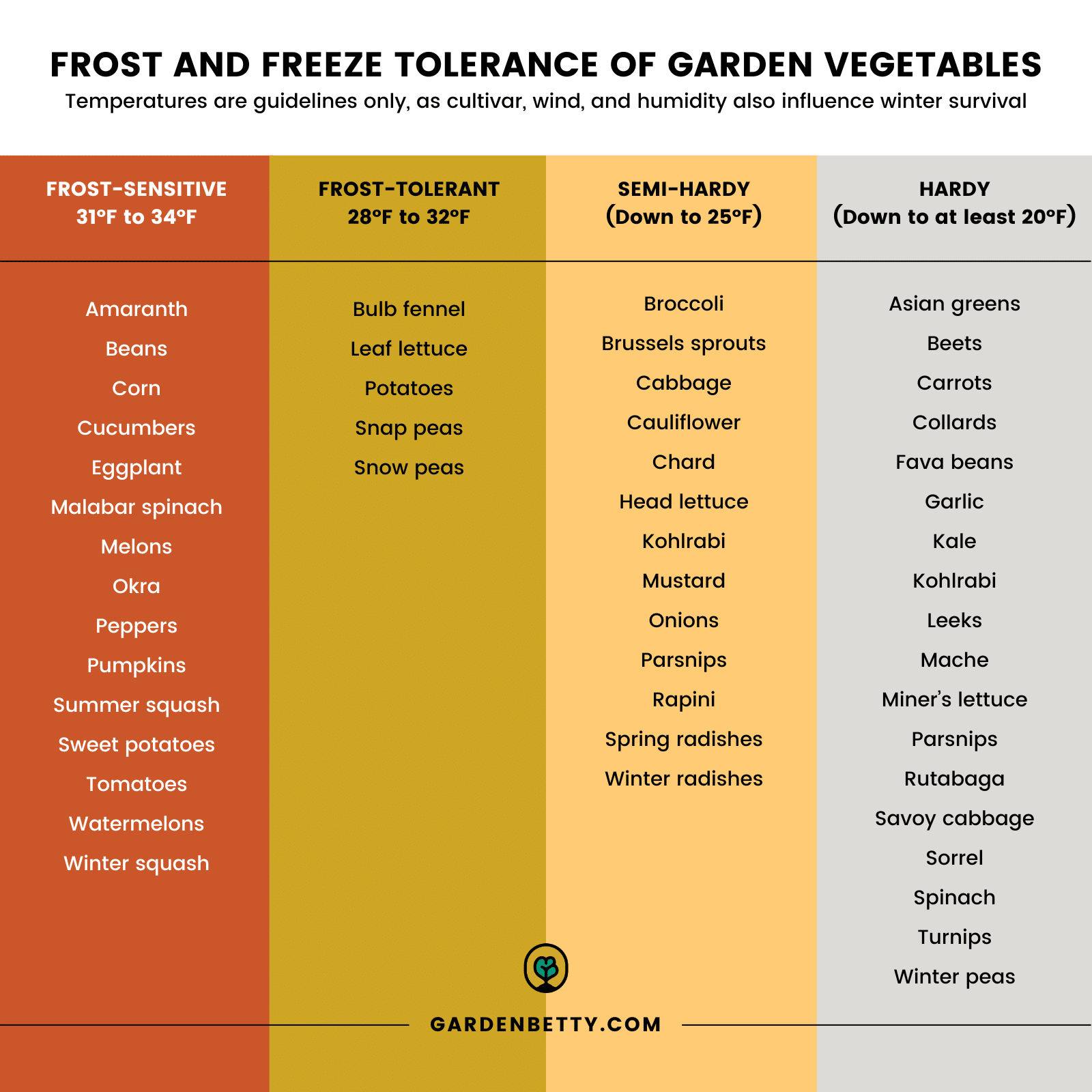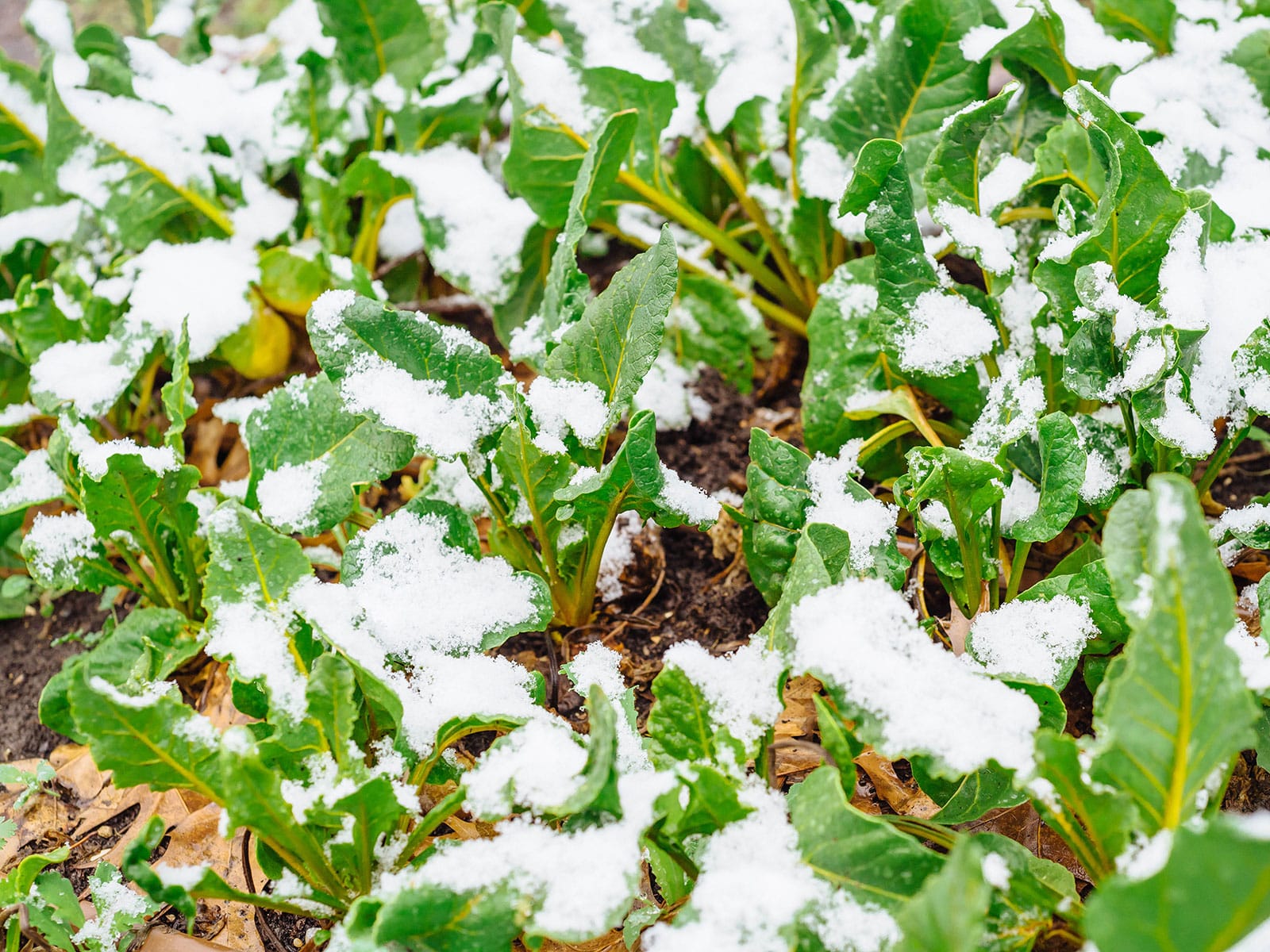If you live below USDA hardiness zone 8, you’ve probably written off winter gardening.
And for a while, I thought the same way. I garden in a zone 5 microclimate at 4,000 feet elevation, where our frost-free growing season is (at best) only 50 days out of the year. But through trial and error, I’ve learned that a hard frost does not usher in the end of the season. Even as my fall crops start to fade and the weather turns more wintry, my garden is still—and will be—producing through the holidays and beyond.
I’ve actually been busy sowing seeds and getting transplants in the ground before the soil freezes. In the ground—not in a greenhouse or high tunnel, but right in my backyard in the same raised beds I’ve been using all year.
This might raise an eyebrow if you’ve resigned yourself to thinking winter gardening is impossible in your zone. And if you’ve ever seen those tables showing the minimum temperature limits for growing vegetables, you’ve likely assumed that gardening ends when winter temperatures plummet to 20°F or below.


However. I’m here to tell you that there’s no need to throw in the trowel. I’ve grown all of the vegetables listed on the right side of this table through my zone 5 climate (with repeated dips below 0°F in the depth of winter). Frost-tolerance lists like this one are merely guidelines—you can “cheat” winter just by knowing how plants respond to the cold.
How plants adapt to freezing weather
Cold-tolerant plants have unique adaptation that help their tissues better respond to freezing conditions. They compartmentalize freezing by moving most of the water outside of their plant cells to freeze (which is why frozen plants appear wilted in the morning, but quickly spring back to life once they thaw).
Plants also produce cold-tolerance proteins and sugars (their own natural antifreeze), which act to lower the freezing point of water inside plant cells and inhibit the growth of ice crystals. (This is why certain vegetables end up tasting sweeter if they’re harvested after a few frosts.)
They’ll even change the composition of fats in their cell membranes, giving them a little more flexibility should any ice crystals form. Warm-season crops like tomatoes and peppers don’t have these adaptations, which is why they turn to mush after a freeze. It’s a result of their plant cells bursting as water expands, kind of like a water bottle bursting in the freezer.
What really injures plants
So if cold-tolerant plants can adapt to freezing conditions, what actually damages them? In most of the United States, it’s simply desiccation: the drying effects of cold winter winds. These plants have already moved water out of their cells, then the low humidity and harsh winds of winter dry out their tissues even further.
Early freeze damage typically shows up first on the leaf margins, producing tip burn, or dried crispy edges. And cold-tolerant plants don’t turn to mush when exposed to extreme cold; they simply look dehydrated or brown. So it’s really desiccation—not cold temperatures per se—that frequently damages plants.
Here’s a mature chard plant in my garden, planted in the open, showing tip burn after multiple clear nights below freezing temperatures.


On the other hand, these young chard plants suffered no damage, thanks to an insulating layer of snow.


The exposed outer leaves on this red-veined sorrel became dehydrated after several nights below freezing, while the protected inner leaves are still green and fresh.


Freeze-wrap your garden
With that bit of understanding of how winter actually injures plants, it’s not hard to see how you can cheat the weather. You can push the minimum limits of those frost-tolerance tables simply by giving your plants some protection, either in low tunnels (what I personally use) or cold frames.
It’s easy to think that these structures work by trapping some heat from sunlight during the day and releasing it at night, but there’s so much more to them than that. Think of it like freeze-wrapping your garden.
Disclosure: If you shop from my article or make a purchase through one of my links, I may receive commissions on some of the products I recommend.
In your freezer, freezer burn occurs due to the sublimation of frozen water from the tissues of meats and vegetables. You can prevent this by increasing the humidity in your freezer (which is hard to do), encasing your foods in frozen water, or more commonly, by making sure you have an airtight seal in the packaging around your foods. (I use and recommend this vacuum sealer for long-term storage in the freezer.)
You can mimic this freeze-wrap concept by “packaging” your garden beds into low tunnels or cold frames, which increases the humidity inside the structure (reducing sublimation of water from plant tissues) and protects the plants from drying winds—much in the same way that a good snowfall can insulate plants.
If you’re able to water your garden beds before an expected cold snap, that helps as well. The moisture further raises humidity inside the tunnel and moist soil protects plant roots from drying out.




So, how well does this work? A few winters ago, I had multiple beds planted with several varieties of leaf lettuce. Some were grown in the open, some were grown under clear plastic sheeting, and others were grown under midweight frost cloth (also known as row cover).
According to the frost-tolerance table I shared above, lettuce should die at temperatures below 28°F and yes, some of the ones without protection did. (This is highly dependent on the cultivar; generally, heat-tolerant lettuces are also more cold-tolerant, as contradictory as that sounds.)
But, all the lettuces in the low tunnels easily survived temperatures down into the high teens Fahrenheit. And lettuces that had two layers of frost cloth over them even survived the low teens Fahrenheit (though a few of them did get leaf burn).
How cold did it get inside the tunnels that winter? I had a temperature sensor in the tunnel covered with just one layer of fabric and it got down to 24°F. (From personal experience, I’ve found that medium-weight frost covers like Agribon AG-30 provide around 5° of cold protection.)
So, temperature clearly isn’t the only factor that determines whether a crop will survive winter. (These are the sensors I use throughout my garden to monitor temps and humidity.)
Recommended
Frost protection for plants
Don’t baby your plants
If you want to give winter gardening a shot with these cold-protection tricks, don’t baby them. Just as the cellular changes and sugars they accumulate are induced by cold weather, they’re quickly lost when the plants are exposed to heat.
That means you do need to pay attention to what the weather is doing. Frost cloth is a great option if you prefer to be more hands-free, since cold frames and tunnels covered in plastic need to be vented when temperatures rise to 40°F or above.
On a sunny 40°F winter day, the temperature inside a cold frame or plastic-covered tunnel can easily reach 80°F or more, which causes plants to lose the sugars and antifreeze proteins they’ll need to survive when temperatures plunge at sundown. If you use plastic covers, invest in a temperature sensor and be sure to vent your tunnel if it approaches 60°F inside the tunnel.
(If you can’t decide what kind of cover to get for your low tunnel, I’ve got a guide that compares fabric vs. plastic row covers and when you’d want to use one over the other.)
In my years of gardening in the Central Oregon high desert and harvesting leafy greens all winter, I’m convinced that keeping cool-season plants cool—what they’re naturally adapted for—is the key to successful winter gardening.
For ideas on what you can grow all winter, bookmark my guides on cold-hardy vegetables and cold-hardy herbs that can survive a hard frost.














Which cover do you prefer for lettuce, plastic sheeting or frost cloth for a more hands-free winter gardening?
It really depends on your climate and garden orientation. Personally, I grow lettuce under frost cloth because we do get lots of direct sun all day and winter temps that can climb into the 40s or 50s Fahrenheit, and I can’t always get out there to vent a plastic cover.
Fascinating discussion on growing vegetables in the winter. I have a question, will the vegetables survive if temperatures stay below -10C /14F throughout the day as I live in a zone 3 climate category.
Yes, if you grow cold-hardy vegetables and keep them mulched and covered. In my climate, we’ve had days where the temps never got above 20F all day (with lows in the single digits). One of the things that helps is making sure your soil is adequately moist before a cold spell like that. If it hasn’t rained or snowed in a while, your plants will suffer in winter.
lots of ideas to try. use up old seed packets of greens and experiment. one missing from the list is my all time favourite, named claytonia or winter purslane or miners lettuce. we eat it raw in salads or smoothies, use the whole plant as a puree cooked gently with garlic and cream or in stir fry. It appears everywhere in the poly tunnel around the beginning of November and keeps going until end March or later. self seeds but is not invasive as very easy to pull up. have to watch for slugs.
I have it as miner’s lettuce on the list in the far right column, and yes I love it as a hardy winter green! That and mache will grow all winter for me.